Which ASX shares to buy in a high gold price environment
The gold price has increased by +44.6% to A$4,522/oz over the last 12 months fuelled by central bank demand, inflation, and its role as a safe-haven asset, as gold supply growth remains constrained by declining reserves.
This supply-demand imbalance supports a "higher for longer" gold price outlook, making high-quality gold-related equities a compelling opportunity, in our opinion.
The challenge for investors remains identifying the best expression of this thesis—which companies benefit most, and where are the best opportunities for outperformance? We think investors could do worse than look to Howard Marks, one of the best investors in history, for inspiration.
Who?
Howard Marks, co-founder of Oaktree Capital Management, emphasizes the importance of "second-level thinking" in investment decision-making. In his book The Most Important Thing, Marks contrasts first-level thinking, which is simplistic and superficial, with second-level thinking, which is deep, complex, and contrarian.
He asserts that first-level thinkers focus on immediate, apparent outcomes (e.g., "This company is growing fast, so its stock will go up"), while second-level thinkers delve deeper, considering a range of possible outcomes and their probabilities (e.g., "Everyone knows this company is growing, so its stock is already priced for perfection—what happens if growth slows?").
This approach, and our broader investment philosophy at Seneca Financial Solutions, involves understanding consensus views and identifying how one's perspective may differ. which can enable investors to uncover opportunities that others might overlook. Marks believes that mastering second-level thinking is essential for achieving superior investment returns, as it allows investors to anticipate potential consequences and navigate dynamic, complex market effectively.
In this wire, we discuss how we are attempting to apply the principles of first, second and even third-derivative thinking to generate above-market returns and manage risk during this gold price bull market.
1. First order thinking: Gold miners are making extraordinary profits
The most obvious beneficiaries of a higher gold price are gold miners. With production volumes largely static in the short term, and mining typically an 80% fixed cost business, higher gold prices result in asymmetrically higher profits.
Gold mining companies are cheap in a relative sense, having decoupled from gold prices in USD terms post-COVID – as escalating costs (labour inflation) hampered profitability.
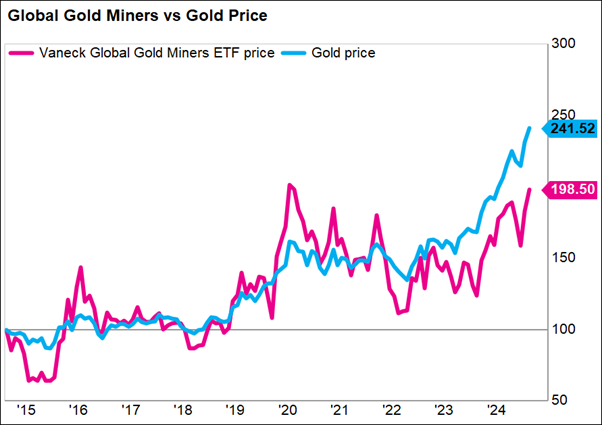
Global gold miners ETF (Vaneck) performance vs gold price (indexed) over last 10 years. Source: Factset
With many investors globally seemingly under-allocated to gold miners, there is potential for a catch-up trade amid higher-for-longer gold prices.
Genesis Minerals (ASX: GMD)
Our top pick of the gold miners is Genesis Minerals, which we own in the Seneca Australian Shares SMA. Genesis operates 2 primary production hubs (Leonora and Laverton) in Western Australia, which is one of the most mining-friendly jurisdictions on the planet. Genesis CEO Raleigh Finlayson and his team bring extensive industry expertise and needs no introduction to experienced and professional investors, having led Saracen Minerals (ASX: SAR) before Northern Star (ASX: NST) acquired it in 2021. Our investment thesis for Genesis is centred around:
- Production Growth: Genesis offers one of the cleanest growth profiles among larger producers. Output is set to increase from ~150koz per annum to ~300koz in the near term, with a clear pathway to 400kozpa, and with operating costs falling by over a third due to scale advantages. There’s also potential to accelerate production at Tower Hill. Genesis has secured key permits for expansion—an increasingly rare achievement in today’s regulatory environment, as we've seen with the ongoing permitting struggles at Regis Resources’ McPhillamys project.
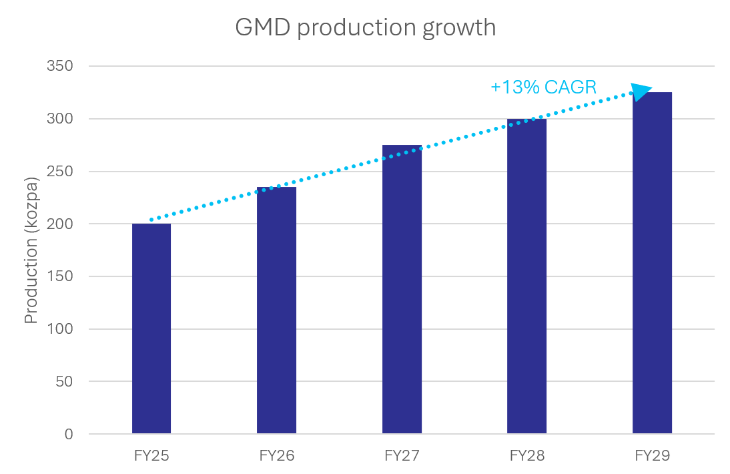
Source: Genesis Minerals, Seneca Financial Solutions
- High quality Assets: Genesis’ resource and reserves base underpin a 15+ year mine life, setting it apart from peers. With 84% of production fully exposed to the gold price, Genesis is also highly leveraged to rising gold prices, offering strong near-term cashflow potential that can be reinvested into further expansion.
- Upcoming Catalysts: In 2025, we expect resource and reserve upgrades and mill expansions to drive share appreciation beyond peers.
2. Second order thinking: 'who benefits from higher gold prices?' - capital raisings
In our mind, a higher gold price results in higher valuations ascribed to gold equities. Higher gold equity valuations incentive equity capital markets activity – with every share price ticking higher, fewer shares need to be issued to raise a particular amount of money.
The second-order beneficiaries of higher gold prices are investment banks and brokers, who generate extraordinary profits from elevated ECM activity. Specifically, this can extend to large investment banks like Macquarie (ASX: MQG), though their diversified revenue streams and exceptional scale dilute this somewhat niche driver. In a stylised and ideal world, we’d want to own a mid-tier broking firm with a stable underlying business, strong cash flow and a proven track record of capturing the blue-sky upside of elevated ECM activity…
Euroz Hartleys (ASX: EZL): asymmetric upside from gold capital raisings
Euroz Hartleys is an underappreciated financial services company with a dominant position in Western Australia’s equity capital markets and wealth management sectors. With $78 million in cash, zero debt, and a highly scalable business model, EZL is primed to capitalize on the recovery in exploration activity and mining capital raisings.
Last upcycle in FY21, Euroz Hartleys made $131 million in revenue and $52.5 million NPAT in a year that saw ECM raisings almost double from the prior year on the back of the gold price rallying +36% from the covid-low.
Despite its proven track record and strong brand, EZL remains overlooked by the broader market due to several factors:
i) Perceived cyclicality – The volatile nature of its ECM revenue leads investors to view it as a highly cyclical and risky business.
ii) Low liquidity – With a market cap of ~$150 million, EZL is tightly held, with 42% insider ownership, including executive chairman Andrew McKenzie’s 8% stake. While this limits trading volume, we view it as a positive rather than a drawback, as it aligns management with shareholders and reduces the risk of short-term decision-making.
iii) Lack of analyst coverage – As a competitor to many brokers, EZL receives little institutional coverage, keeping it off the radar of larger investors.
These factors create a unique opportunity for investors before broader recognition drives a re-rate. The market’s focus on ECM cyclicality overlooks EZL’s highly profitable and growing wealth management division, which manages $3.9 billion in FUM and generates ~$22 million in recurring fee revenue. These businesses typically command ~3x recurring revenue multiples.
Meanwhile, EZL’s strong cash backing and diversified business model provide downside protection, insulating it from a gold or commodity price downturn.
EZL’s recent trading update highlights its operating leverage. It delivered $6.25 million NPAT on $50 million revenue—a 501% profit increase from the prior period. This demonstrates how quickly earnings can scale as capital markets activity rebounds. The company’s dominant position in the junior gold financing space, combined with early signs of increased capital raisings, suggests earnings momentum is just beginning.
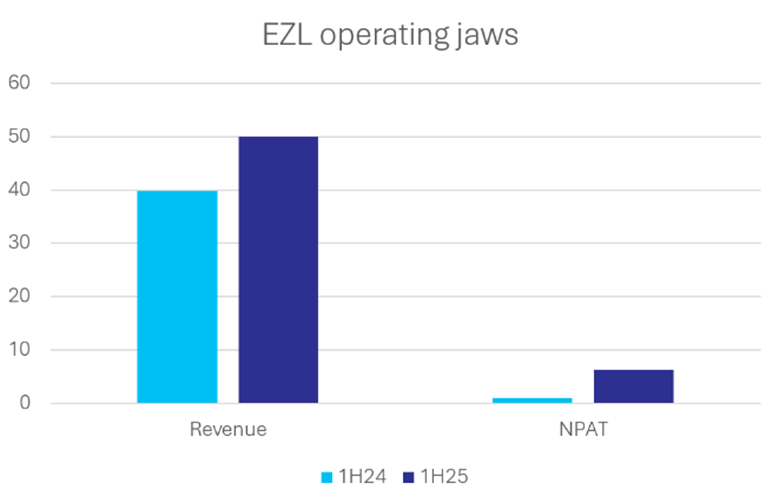
Source: Euroz Hartleys, Seneca Financial Solutions
We think we are at the start of a cyclical upswing in corporate activity that could materially increase Euroz Hartley’s earnings.
With a market cap of $146 million and an enterprise value of just $53 million, investors are essentially getting part of the operating businesses for free after accounting for cash. A sum-of-the-parts valuation suggests a fair value of $1.50 per share, representing 50% upside.

Source: Good Research estimates.
With a 5% fully franked dividend yield, a highly aligned management team, and a history of capital returns, we see scope to return some Excess cash on the balance sheet which could serve as a major catalyst for the stock.
While a 2 cents per share fully franked dividend is nice, we think the company has capacity to return $30 million - $50 million of capital, which improves the IRR from 50% to 73% on our numbers as the 'stub' business becomes more valuable off a lower base.
We await the EZL's upcoming financial results, where capital management intentions will likely be disclosed.
3. Third order thinking: 'where does the money go?' - exploration expenditure
Taking our analysis a step further, after Euroz Hartleys raises all this money for all these mining companies, where does it go?
Picks and shovels pick #1: Imdex (ASX: IMD)
Imdex is a global leader in drilling technology for the mining sector, enabling miners to drill smarter, faster, and more accurately.
Its specialised drilling fluids improve efficiency and reduce costs, while its downhole surveying tools ensure drilling stays on target. Additionally, its data analytics software gives miners real-time insights into what’s underground, helping them make better decisions before committing to costly projects. In short, Imdex helps mining companies save money, reduce risk, and maximize their chances of making discoveries and defining economic resources. Despite an impressive ~70% global market share in its core niche of advanced mining tools and orebody knowledge technologies, the market underestimates the company’s earnings power and value.
Cyclical lows in exploration expenditure in gold and copper, key commodities that Imdex is ~75% exposed to, saw shares sell off to a low of ~$1.50, around where we started accumulating in the Seneca Australian Small Companies Fund, with our thesis built on higher gold prices supporting development and exploration drilling, of which Imdex is a unique beneficiary – using its technology solutions to delineate deeper and lower-grade deposits.
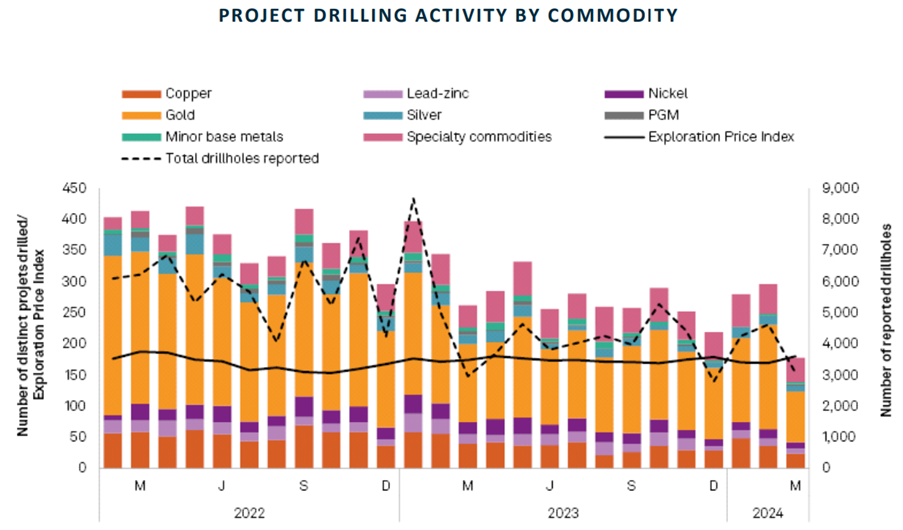
Source: S&P Global, April 2024.
Despite the 90% share price rally since then, we believe the market is continuing to underestimate the leverage Imdex has to increasing drilling activity in base and precious metals.
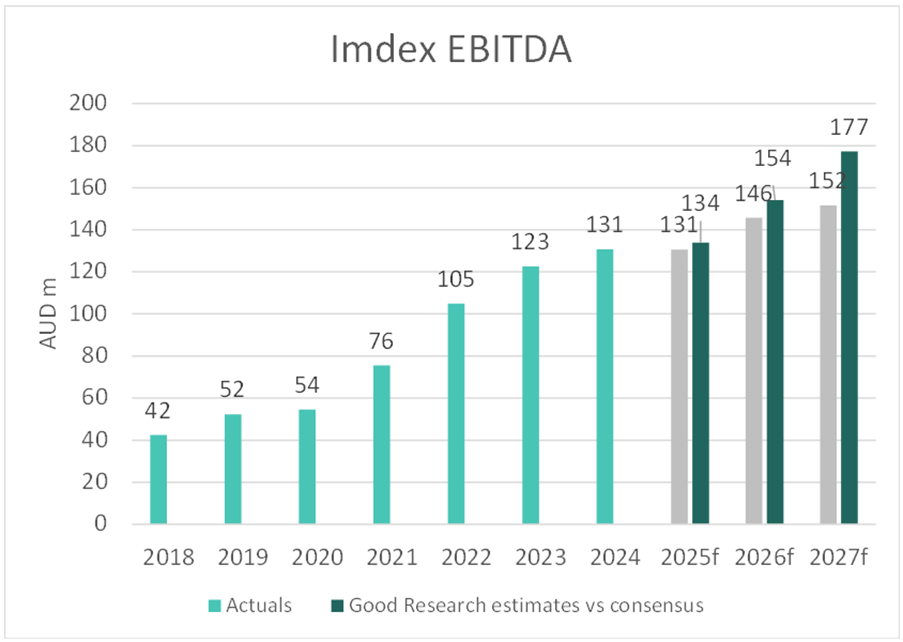
Source: Factset, Good Research, November 2024.
This was demonstrated last week, with Imdex again beating consensus analyst estimates, reporting $64 million EBITDA for the half, 7% ahead of consensus, and robust 73% gross, which have incrementally increased by ~50bps each half over the last 8 years due to an improving product mix (more sensors and SaaS).
At $1.5 billion market cap, we see Imdex as a strong candidate for inclusion in the flagship S&P/ASX 200 index (XJO) this year, which would trigger a wave of passive buying associated with ETFs which we predict could account for >20x median daily IMD volume. We see a path to $3.50+ for Imdex.
Picks and shovels pick #2: XRF Scientific (ASX: XRF)
XRF Scientific sells laboratory equipment and consumables. Despite being under the radar of most investors and fund managers at a $268 million market cap, XRF has built a formidable competitive position that we liken to being a mining assay toll road for laboratory analysis and testing.
XRF operates on a razor-and-blades business model, selling sample analysis machines at low margins while generating high-margin revenue from consumables and platinum-wares. Its success is driven by expertise in chemistry (bespoke depending on each individual orebody, and high value), fast turnaround times, and strong customer relationships, which have helped it establish a dominant market position. In its highest-margin consumables division, XRF now holds 5x the market share of its nearest competitor, (a division of a Canadian group from which XRF has been actively winning customers—even in Canada.).
This competitive edge has enabled XRF to consistently grow revenue and expand margins.
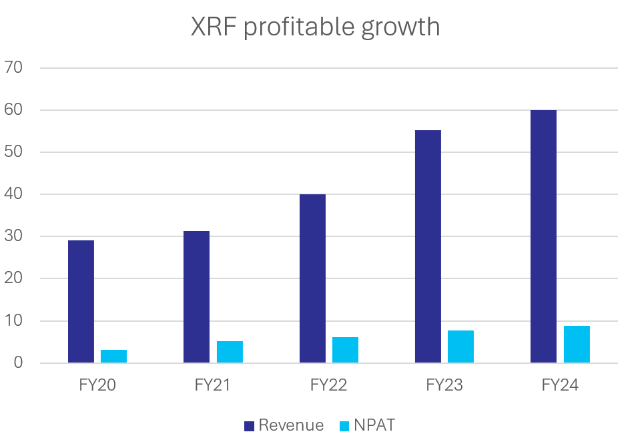
Source: XRF Scientific, Seneca Financial Solutions
XRF’s management has consistently demonstrated disciplined capital allocation and a keen eye for value-accretive acquisitions. A prime example of this is its investment in Orbis Mining, a developer of gold lab sample crushing systems. In September 2021, XRF acquired a 50% stake in Orbis for $0.8 million, when the business was generating $2.3 million in revenue. Over time, the total acquisition cost increased to approximately $4.7 million, as the final price was tied to Orbis’ earnings, which surged under XRF’s leadership.
Since the acquisition, Orbis has become the go-to solution in the gold testing industry, offering a single-pass sample splitting system, a major efficiency improvement over competitors. The business has delivered cumulative profits before tax of $3.74 million from FY21 to FY24, putting XRF on the verge of recouping its entire investment. In other words, XRF is close to being "free-carried" on this acquisition.
Despite Orbis’ success, many small-cap fund managers remain unaware of XRF, instead focusing on overvalued, riskier testing companies like Chrysos (ASX: C79), which gained attention due to its large IPO and broker coverage. However, XRF actually benefits from higher Chrysos sales (samples must be crushed before undergoing fire assay) while trading at a much more attractive valuation—14x EV/EBITDA vs. C79 at 22x, or a 3.7% free cash flow yield (and growing) vs. C79’s -7.9%.
XRF continues to leverage its existing distribution network to generate earnings accretion by cross-selling complementary lab products, including the recent Labfit acquisition and other new products expected to be released in 2025.
Backed by a rock-solid balance sheet with ~$10 million in net cash, a fully franked dividend, and a management team led by CEO Vance Stazonelli that prioritizes execution over hype, we remain comfortable long-term holders of XRF.
3. Third order thinking part II: 'Where does the money go?' - M&A
Strong balance sheets and elevated equity market valuations often entice management teams to acquire smaller peers to grow production, extend mine life, or realise some of the synergies that typically arise in mining when you add scale. We previously covered this in detail for the Livewire audience in this wire.
Northern Star (ASX: NST)’s scrip bid for De Grey Mining (ASX: DEG) is highly instructive. Northern Star adds a large-scale, long-life growth project to its portfolio and can add value in the crucial ramp-up phase of mining via its similar experience with processing methods for similar semi-refractory orebodies.
Antipa Minerals (ASX: AZY)
Using this framework, we’ve added Antipa Minerals to the Seneca Australian Small Companies Fund, which we believe will attract a takeover bid from Greatland Gold prior to its upcoming IPO. Antipa Minerals is sitting on one of the most strategically valuable gold resources in Western Australia, with its 2.3Moz Minyari Dome Project located just 35km from Greatland Gold’s Telfer processing plant.
Following Newmont (ASX: NEM)’s sale of Telfer and Havieron to Greatland Gold (LSE: GGP) in September 2024, the clock is now ticking for Greatland to secure additional ore feed to maximize its underutilized 20Mtpa plant capacity—and Minyari Dome is the most logical source, in our opinion.
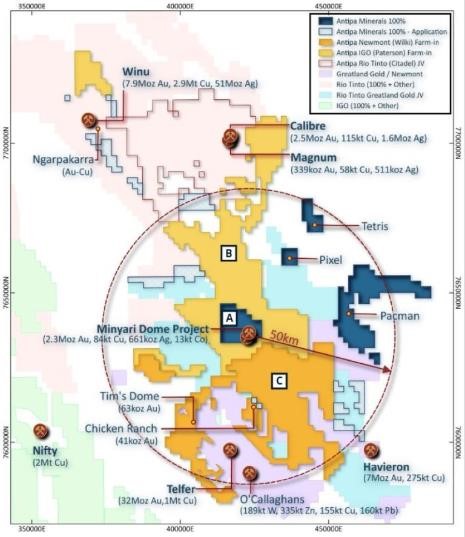
Source: Antipa Minerals announcements
AZY’s Minyari Dome economics stand strong on a standalone basis, with a A$594 million NPV (after tax) and a 52% IRR at A$3,000/oz gold (significantly below spot price), underpinned by a 10-year mine life. Yet, at a $185 million fully diluted market cap, AZY remains deeply undervalued, trading at just $67/oz EV/Resource, compared to the $137/oz historical average from our analysis of 23 junior gold M&A transactions over the past five years. If AZY were to be valued in line with these transactions, it would imply a +104% upside from current levels.
But the real value unlock is through processing at Telfer. By hauling Minyari ore 35km to Telfer instead of building a standalone plant, AZY could save approximately $200 million—nearly two-thirds of the required capex for its own mill—while boosting project NPV to ~$800 million at the same A$3,000/oz gold assumption, equating to ~16 cents per share (pre-consolidation), 4x the current share price. Run spot gold prices through those assumptions, and the numbers only improve. Admittedly, Greatland wouldn’t pay 1.0x NPV for a development asset, but the point remains that even after incorporating a hefty discount, Greatland could justify a hefty premium for AZY, and it would still be accretive.
Greatland has already inherited an 8.5% stake in Antipa from Newmont, further reinforcing the likelihood of a deal. With Greatland’s ASX listing set for mid-2025, a transformational acquisition ahead of the IPO would be a logical move to strengthen its growth story.
The timing has never been better. Telfer’s reserves are depleting, Greatland needs ore now, with only 15 months of estimated feed left at Telfer, and AZY is the only nearby development-ready asset that fits the bill.
The Minyari Dome resource grades 1.51g/t gold—more than twice Telfer’s total resource grade of 0.67g/t gold. Additionally, Minyari Dome is near the surface, making it far more accessible when compared to Greatland’s other asset, Havieron, where mineralization sits ~400m below Permian cover. Although Havieron will utilise a portion of the mill capacity, with 2x 10Mtpa processing trains, there is plenty of latent throughput potential for additional high-grade feed.
We recently profiled AZY to our Good Research subscribers at 2.5 cents per share (pre-consolidation), the same price at which the fund participated in the placement in December 2024. This left the company cashed-up to progress feasibility studies and exploration.
In addition, AZY offers a free option on a prospective 3,920sqkm of tenure in the Paterson province, including joint venture ground where Newmont and IGO will fund exploration to earn into the projects.
James Bay Minerals (ASX: JBY): A Deeply Misunderstood High-Upside Gold Play
James Bay Minerals has secured what we believe to be one of the best gold deals on the ASX, acquiring the Independence Gold Project in Nevada for a total purchase price of ~$4/oz, in a region where peers trade for many multiples of that. The project's previous owner, an undercapitalized private company and motivated seller presented a rare opportunity to acquire a high-quality asset at a deep discount—a feat that’s increasingly difficult to achieve in gold M&A as prices rise.
JBY's Independence gold project sits directly adjacent to the Phoenix/Fortitude Mine, owned by Nevada Gold Mines (NGM)—a joint venture between A$47 billion Barrick Gold (NYSE: GOLD) and A$83 billion Newmont (ASX: NEM). NGM is one of the world’s largest gold producers, accounting for over 3 million ounces annually.
As we pointed out in relation to another stock - Sun Silver (ASX: SS1) - here on Livewire, Nevada, USA, is a state that is not only a tier 1 jurisdiction but consistently ranks in the top 3 jurisdictions to operate globally, per the Fraser Institute.
JBY's project has a resource of 1.18Moz gold and 7.6Moz silver (NI-43 foreign resource estimate), including a high-grade component of 796,200oz at 6.53g/t Au, open in all directions. However, we believe the low-grade, near-surface component of the resource is fundamentally misunderstood across the market, and should it prove amenable to low-cost heap leaching, a process that other nearby miners commonly practice. If this forecast proves accurate, there is substantial shareholder value on offer from the current market capitalisation of only 60 million.
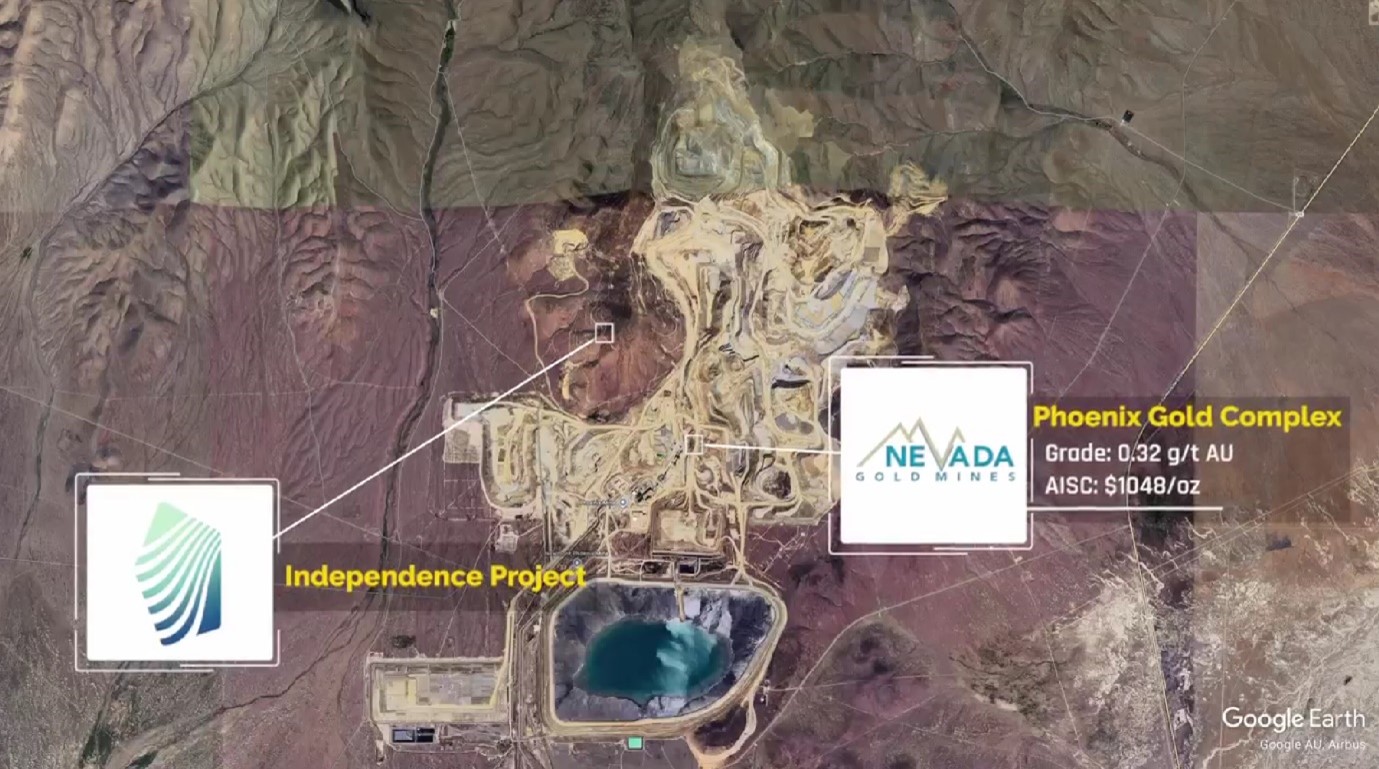
Source: James Bay Minerals
Australian investors traditionally snub sub-1g/t gold grades, but in Nevada, heap leaching enables highly profitable production at much lower grades. For example, the neighbouring Phoenix Mine operates exceptionally profitably at just 0.32g/t gold, with an AISC of US$1,050/oz. SSR Mining (ASX: SSR)’s Marigold Mine remains profitable at an eye-wateringly low grade of just 0.17g/t gold. These examples highlight the untapped potential of JBY’s 0.37g/t oxide resource, which remains overlooked by the market despite its strong economics.
Too good to be true?
Soft oxide ores are ideal for heap leaching – a process where ore is dug up, lightly crushed, stacked into piles (or heaps), and irrigated with a cyanide solution using basic PVC piping.
Challenges with heap leaching can include volatile weather conditions, environmental regulations, a lack of available land or steep terrain – none of which are an issue in Nevada.
From our analysis of Nevada heap leach gold production, recoveries of 60-80% with minimal processing costs are the norm, with strip ratios as low as 0.5:1. While difficult for the average Australian gold-focused investor to comprehend, mining in Nevada is more akin to large-scale earth-moving operations with operating costs at the Phoenix mine next door to JBY’s as low as A$10 per tonne—a stark contrast to Australia’s >A$100 per tonne underground operations.
If you wanted to draw an Australian comparison, we think the Pilbara iron ore market is the most analogous. In the Pilbara lower-grade hematite DSO remains superior to higher-grade magnetite due to its simplicity, scalability, and cost efficiency.
Australian investors have been conditioned to evaluate gold deposits based almost exclusively on high-grade intercepts. With discoveries like Bellevue Gold (BGL)’s namesake Bellevue gold project hosting a resource of 3.2Moz @ 9g/t Au, attracting a market capitalization in excess of $1.5 billion despite the hard economic reality that mining costs came in at A$259 per tonne in the December quarter, eroding margins despite the higher grades. (For completeness, Bellevue is in its ramp-up mining phase but hasn't enjoyed the re-rate that gold peers have had over the last 12 months and has only just disclosed the crucial all-in-sustaining-costs metric to investors for the first time in January).
James Bay Minerals (ASX: JBY) listed on the strength of its prospective lithium assets in Quebec, along trend from Patriot Battery Metals’ (ASX: PMT) world-class Corvette discovery. We covered it here. However, the downturn in lithium prices has forced JBY to diversify its focus to maintain investor interest, as exploration is capital-intensive, particularly in James Bay.
Despite retaining its lithium assets, the company has scaled back drilling due to the high operating costs in the remote region, where drilling expenses can reach $1,000 per meter. Even strong lithium drill results are struggling to gain market traction, as evidenced by QTWO Metals’ latest hits (which were nothing short of exceptional - highlights included 347m @ 1.35% Li2O. The share price doubled to $1.48 per share on the news, before falling back to $0.78 by the end of Jan). With ~$2 million already spent to secure tenure until 2026, JBY has shifted its priorities toward acquiring a lower-cost, near-term development asset to drive shareholder value.
Sidebar: Many might be sceptical of this sort of ‘pivot.’ In our opinion, we view junior mining entrepreneurs who are realistic and willing to adapt (and do so while protecting shareholder capital) positively. This aligns with the culture Luke Laretive has been fostering at Seneca for years —encouraging people to be brave enough to change their mind. The only thing worse than making a mistake is compounding the error in a bid to protect your ego.
Beyond its near-term gold production potential, JBY has multiple levers of 'low-hanging fruit' to expand the resource at the Independence project. The high-grade skarn zone remains open in all directions, while infill drilling and underexplored areas—previously neglected by owners unwilling to spend ~$150k on a short access road to reach uphill sections of the property or assay entire drill core sections—offer straightforward growth opportunities. With US$25M already spent on exploration, JBY is positioned for a major resource upgrade at minimal cost.
Located immediately west of NGM’s Phoenix/Fortitude Mine, Independence presents a compelling bolt-on acquisition opportunity. It offers near-surface, high-margin ounces, along with permitting advantages and proximity to major infrastructure. On an EV/Resource valuation, JBY trades at just $41/oz, a steep discount to M&A transactions that have historically occurred at an average of $137/oz. A conservative takeover scenario values JBY at $1.60+ (234% upside), with blue-sky potential of $2.50+ (5-6x upside) upon resource expansion.
At just a $60 million market cap, we view JBY as one of the most mispriced, asymmetric opportunities on the ASX today. In our view, the Nevada majors won’t ignore this forever.
Learn more about the Seneca Australian Small Companies Fund here.
5 topics
15 stocks mentioned
1 contributor mentioned

